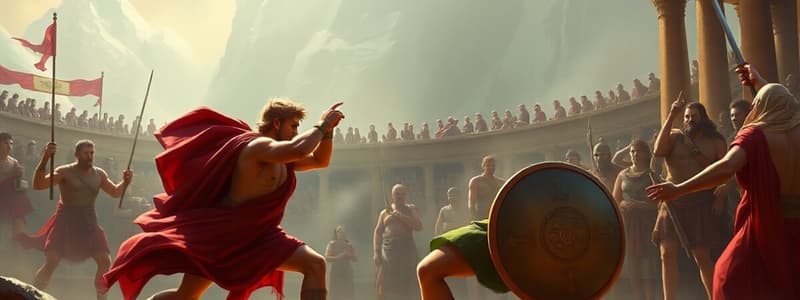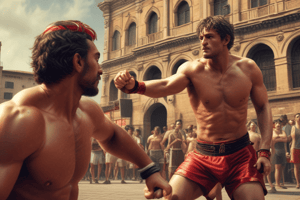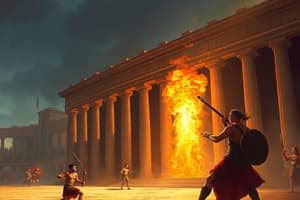Podcast
Questions and Answers
What was Spartacus' initial plan after passing the Alps?
What was Spartacus' initial plan after passing the Alps?
- To establish a new kingdom in Italy
- To continue ravaging Italy
- To launch a final attack on Rome
- To return each man to his homeland (correct)
What was the outcome after Crassus was tasked with suppressing the rebellion?
What was the outcome after Crassus was tasked with suppressing the rebellion?
- The rebellion was crushed and the leaders were captured (correct)
- Spartacus successfully overthrew the government
- Pompey betrayed Crassus during the campaign
- Crassus' forces suffered heavy losses
What was one reason Spartacus did not sack Rome?
What was one reason Spartacus did not sack Rome?
- He believed it was strategically unwise (correct)
- His forces were too weak for a siege
- He had lost the support of his soldiers
- He had a secret pact with the Senate
What action was taken against the surviving slaves after the rebellion was crushed?
What action was taken against the surviving slaves after the rebellion was crushed?
When was the last recorded gladiatorial competition in Rome?
When was the last recorded gladiatorial competition in Rome?
What type of gladiator was primarily recognized for their specific fighting style involving minimal armor?
What type of gladiator was primarily recognized for their specific fighting style involving minimal armor?
What distinguished an eques from other types of gladiators?
What distinguished an eques from other types of gladiators?
Which group of individuals was known to fight without any means of defense against animals like lions?
Which group of individuals was known to fight without any means of defense against animals like lions?
What was a significant outcome for female gladiators after Emperor Septimius Severus's decree?
What was a significant outcome for female gladiators after Emperor Septimius Severus's decree?
What particular oath did Spartacus and other gladiators take upon training?
What particular oath did Spartacus and other gladiators take upon training?
Which characteristic described the living conditions of gladiators at training grounds?
Which characteristic described the living conditions of gladiators at training grounds?
What was one reason gladiators were emotionally distant from each other?
What was one reason gladiators were emotionally distant from each other?
Which gladiatorial combat style was particularly popular among audiences?
Which gladiatorial combat style was particularly popular among audiences?
What was the primary purpose of the Colosseum?
What was the primary purpose of the Colosseum?
How did the Roman view of themselves contrast with gladiatorial entertainment?
How did the Roman view of themselves contrast with gladiatorial entertainment?
What significant feature did the Colosseum possess to enhance performances?
What significant feature did the Colosseum possess to enhance performances?
What training did new gladiators undergo?
What training did new gladiators undergo?
What was a common fate for gladiators in the arena?
What was a common fate for gladiators in the arena?
What role did aging notables play in the gladiatorial games?
What role did aging notables play in the gladiatorial games?
Which of the following statements accurately describes the audience at the Colosseum?
Which of the following statements accurately describes the audience at the Colosseum?
What method was employed to prepare for naval reenactments in the Colosseum?
What method was employed to prepare for naval reenactments in the Colosseum?
What was Spartacus's primary motivation for leading the rebellion?
What was Spartacus's primary motivation for leading the rebellion?
What notable tactic did Spartacus and his men use to escape from the training center?
What notable tactic did Spartacus and his men use to escape from the training center?
What did Spartacus and his followers do after taking refuge on Mount Vesuvius?
What did Spartacus and his followers do after taking refuge on Mount Vesuvius?
What significant event did Spartacus's rebellion provoke in Roman history?
What significant event did Spartacus's rebellion provoke in Roman history?
What was a key consequence of Spartacus's initial military successes?
What was a key consequence of Spartacus's initial military successes?
Which geographical route did some of Spartacus's followers plan to take after the rebellion?
Which geographical route did some of Spartacus's followers plan to take after the rebellion?
How did Spartacus's army acquire weapons during their revolt?
How did Spartacus's army acquire weapons during their revolt?
What internal conflict arose within Spartacus's army regarding their future actions?
What internal conflict arose within Spartacus's army regarding their future actions?
Flashcards
Gladiator Entertainment
Gladiator Entertainment
A violent form of entertainment in ancient Rome, featuring combat between gladiators.
Colosseum
Colosseum
A massive amphitheater in Rome, primarily for gladiator contests and public spectacles.
Gladiators
Gladiators
Trained combatants who fought in the arenas of ancient Rome.
Roman Entertainment
Roman Entertainment
Signup and view all the flashcards
Public Spectacles
Public Spectacles
Signup and view all the flashcards
Underground Chambers
Underground Chambers
Signup and view all the flashcards
Slaves as Gladiators
Slaves as Gladiators
Signup and view all the flashcards
Class of Gladiators
Class of Gladiators
Signup and view all the flashcards
Spartacus's escape
Spartacus's escape
Signup and view all the flashcards
Third Servile War
Third Servile War
Signup and view all the flashcards
Gladiator rebellion
Gladiator rebellion
Signup and view all the flashcards
Slave army growth
Slave army growth
Signup and view all the flashcards
Leaders of the rebellion
Leaders of the rebellion
Signup and view all the flashcards
Plundering of Capua
Plundering of Capua
Signup and view all the flashcards
Siege of Mount Vesuvius
Siege of Mount Vesuvius
Signup and view all the flashcards
Slave army strategy
Slave army strategy
Signup and view all the flashcards
Gladiator Types
Gladiator Types
Signup and view all the flashcards
Murmillo Gladiator
Murmillo Gladiator
Signup and view all the flashcards
Spartacus
Spartacus
Signup and view all the flashcards
Gladiator Training
Gladiator Training
Signup and view all the flashcards
Female Gladiators
Female Gladiators
Signup and view all the flashcards
Gladiator Training Grounds
Gladiator Training Grounds
Signup and view all the flashcards
Audience Entertainment in Gladiatorial Combat
Audience Entertainment in Gladiatorial Combat
Signup and view all the flashcards
Language Barriers in Gladiator Schools
Language Barriers in Gladiator Schools
Signup and view all the flashcards
Spartacus's Goal
Spartacus's Goal
Signup and view all the flashcards
Rebellious Confidence
Rebellious Confidence
Signup and view all the flashcards
Sacking Rome?
Sacking Rome?
Signup and view all the flashcards
Crassus' Suppression
Crassus' Suppression
Signup and view all the flashcards
Study Notes
Chapter 17 - The Gladiators
- The gladiator's bloody wound signifies the end of his life.
- The cries of the crowd, like roaring tigers, fill the air.
- Aging notables add dignity to the arena.
- Gladiators kneel over the dead bodies of the young, their wounds showing.
- They ravenously suck blood, believing it will prolong their lives.
- Fresh blood from the sun
Gladiatorial Entertainment in Rome
- Gladiatorial entertainment was a violent and bloody aspect of Roman society, contrasting with their sophisticated image.
- The Colosseum, completed in 80 CE, was a massive theater designed for gladiatorial combats and public spectacles.
- The Colosseum could hold up to 50,000 spectators.
- Playwrights used the Colosseum to recreate famous battles and mythological stories.
- Public executions and sea battles were also performed there.
- Underground tunnels and chambers housed slaves and animals used in the performances.
Gladiators in the Arena
- Gladiators came in various classes, such as thraex, murmillo, eques, and essedarius, distinguished by their armor and weapons, and experience.
- Some gladiators fought animals, while others fought each other.
- Christians were sometimes thrown to the arena to fight against lions without any defense.
- Women gladiators were present until the 2nd century CE when they were banned.
Spartacus' Rebellion
- Spartacus, a Thracian slave, was one of the famous gladiators who led a rebellion.
- He and his fellow gladiators escaped from the Capua training camp, recruited others, and gained support of other slaves in Italy.
- They plundered Capua, taking weapons and armor, and fought their way to Mount Vesuvius.
- The rebellion became the Third Servile War, which ended with the gladiators' defeat.
- Approximately 6,000 surviving gladiators were crucified along the road back to Rome.
- The last recorded gladiatorial show in Rome was in 399 CE.
Studying That Suits You
Use AI to generate personalized quizzes and flashcards to suit your learning preferences.




